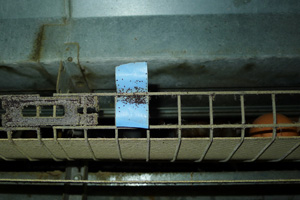Catching red mite through tape-traps

The Poultry Red Mite (PRM) Dermanyssus gallinae is more of a micro predator, rather than a typical parasite. This pest develops off-host and occasionally grasps on any host individual to have a quick blood-meal.
PRM mites are used to aggregate in narrow interstices, of which lots are available in farm buildings. Therefore, it is very difficult both to have a good estimation of the infestation rate with PRM and to control their population. In order to improve this pest’s control and develop efficient sustainable control means, knowledge of the spatial and time distribution of PRM populations within a building is required.
An easy to-use, quick and cheap passive trap method allowing monitoring and surveillance of PRM, was developed in France.
The catching method, consisting of a simple tape-trap attached around a bar of a selected point in cage or free-range systems, allows detection of mites in situ without any laboratory analyses. The designers found from follow-up experiments, that tape-traps provide shelters to freshly engorged mites suggesting hence that the tape-traps catch dynamic mites seeking for a post-prandial rest.
This catching method has proved to be easy to use by both scientific experimentalists and by farmers and other poultry-farming stakeholders for monitoring and following spatio-temporal distributions of PRM populations within buildings.
Source: D. Bicout, Biomathematics and Epidemiology Lab, Lyon, France, L. Roy, University of Montpellier, France, G. Chiron and S. Lubac, ITAVI poultry research institute, Lyon, France
Proceedings of the XIVth European Poultry Conference, June 2014, Stavanger, Norway












